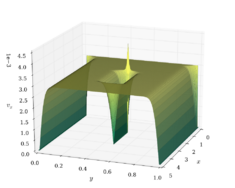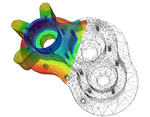Inexact differential equation
| Differential equations |
|---|
 |
| Classification |
| Solution |
An inexact differential equation is a differential equation of the form (see also: inexact differential)
- [math]\displaystyle{ M(x,y) \, dx+N(x,y) \, dy=0, \text{ where } \frac{\partial M}{\partial y} \ne \frac{\partial N}{\partial x}. }[/math]
The solution to such equations came with the invention of the integrating factor by Leonhard Euler in 1739.[1]
Solution method
In order to solve the equation, we need to transform it into an exact differential equation. In order to do that, we need to find an integrating factor [math]\displaystyle{ \mu }[/math] to multiply the equation by. We'll start with the equation itself. [math]\displaystyle{ M\,dx+N\,dy=0 }[/math], so we get [math]\displaystyle{ \mu M\,dx+\mu N\,dy=0 }[/math]. We will require [math]\displaystyle{ \mu }[/math] to satisfy [math]\displaystyle{ \frac{\partial\mu M}{\partial y}=\frac{\partial\mu N}{\partial x} }[/math]. We get
- [math]\displaystyle{ \frac{\partial\mu}{\partial y}M+\frac{\partial M}{\partial y}\mu=\frac{\partial\mu}{\partial x}N+\frac{\partial N}{\partial x}\mu. }[/math]
After simplifying we get
- [math]\displaystyle{ M\mu_y-N\mu_x+(M_y-N_x)\mu = 0. }[/math]
Since this is a partial differential equation, it is mostly extremely hard to solve, however in some cases we will get either [math]\displaystyle{ \mu (x,y) =\mu (x) }[/math] or [math]\displaystyle{ \mu (x,y) =\mu (y) }[/math], in which case we only need to find [math]\displaystyle{ \mu }[/math] with a first-order linear differential equation or a separable differential equation, and as such either
- [math]\displaystyle{ \mu(y)=e^{-\int{\frac{M_y-N_x}{M} \, dy}} }[/math]
or
- [math]\displaystyle{ \mu(x)=e^{\int{\frac{M_y-N_x}{N} \, dx}}. }[/math]
References
Further reading
- Tenenbaum, Morris; Pollard, Harry (1963). "Recognizable Exact Differential Equations". Ordinary Differential Equations: An Elementary Textbook for Students of Mathematics, Engineering, and the Sciences. New York: Dover. pp. 80–91. ISBN 0-486-64940-7. https://books.google.com/books?id=iU4zDAAAQBAJ&pg=PA80.
External links
- A solution for an inexact differential equation from Stack Exchange
- a guide for non-partial inexact differential equations at SOS math
 |


